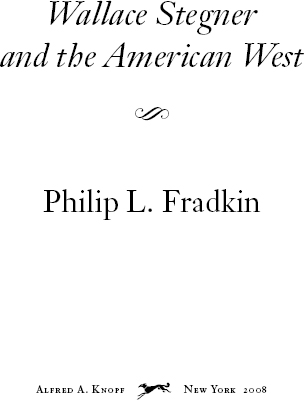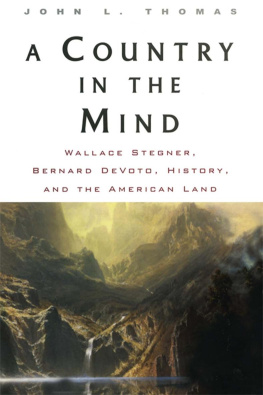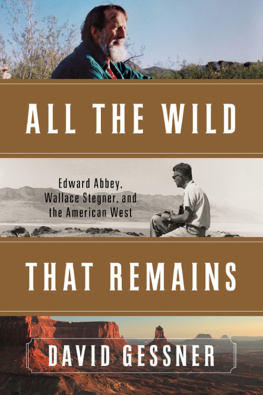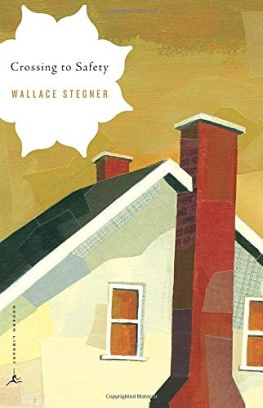

CONTENTS
Again for my father,
Leon Henry Fradkin,
who was also a gentleman and passed on
his love for the West to me
Ive made a kind of American hegira from essential poverty through the academic world, from real ignorance (my parents never finished the sixth grade) to living in a world where my natural companions are people of real brilliance. As Americans, it seems to me, we are expected to make the whole pilgrimage of civilization in a single lifetime. Thats a hell of a thing to ask of anybody.
Wallace Stegner, in David Dillon, Times Prisoners: An Interview with Wallace Stegner
The past keeps feeding into the present. It isnt lost and thrown overboard as much as it seems to be. It isnt as useless or as irrelevant as it seems to be. The past controls you a whole lot more than you might want to be controlled.
Wallace Stegner, in Forrest G. Robinson and Margaret G. Robinson, An Interview with Wallace Stegner
Nearly self-explanatory, the oxymoronic-seeming term angle of repose designates the maximum angle at which a slope of loose material (such as soil or sand) remains stable. It is the point at which gravity challenges friction, the tense moment before one succumbs to the other. Its a term begging to be made metaphorical for human relations, as Wallace Stegner demonstrates in his Pulitzer Prizewinning novel by the same name. In the book, the fraught connection of the present to the past, one generation to the next, replicates the peculiar tension between friction and gravity, between hanging on and falling apart. You were too alert to the figurative possibilities of words not to see the phrase as descriptive of human as well as detrital rest, Stegner writes. As you said, it was too good for mere dirt; you tried to apply it to your own wandering and uneasy life. It is the angle I am aiming for myself, and I dont mean the rigid angle at which I rest in this chair.
Antonya Nelson, Angle of Repose, in Home Ground: Language for an American Landscape
INTRODUCTION
P AST ATTEMPTS to assess Wallace Stegner have judged him on the terms he preferred, as a writer of novels. Writing novels was really all he wanted to do. But he had another full-time occupation and a part-time avocation. Stegner needed to teach in order to support his family, and the nonfiction words he produced propelled him, somewhat reluctantly, into the ranks of the conservation activists.
Stegner made remarkable contributions as a writer, teacher, and conservationist. What he achieved in any one of those fields would have gained him lasting recognition in the West. The complete Stegner package, however, reached beyond regional boundaries. The uniqueness of Stegners contributions was also the cause of his diminishment, because scholars and critics were unable to recognize the totality of the mans achievements. They needed to put him into a niche. So they made him a novelist, as he asked them to.
The two previous biographies of Stegner were written by professors of literature who were mainly interested in him as a literary figure. They didnt deal very extensively with the fact that he was human, meaning that, like the rest of us, he was flawed. I am more intrigued by the whole manor as close as I can get to himset against the passing backdrops of his life. This is a book about a man and the physical landscapes he inhabited and how they influenced him. Within that framework it is also the story of a quintessential westerner who eventually could not deal with the wrenching changes that are a constant of the American West.
Synecdoche, meaning a specific example used to illustrate a generality, was one of Stegners favorite words and writing techniques. In a similar fashion, I use the life of Wallace Stegner as the vista from which to gaze upon the panorama of the American West in the twentieth century, for his time spanned the transition from prairie frontier to Silicon Valley. Stegner inhabited all of the Wests different landscapes physically, emotionally, and mentally, as well as in his writings. The prairies, mountains, deserts, plateaus, rivers, coast, remote villages, small towns, and cities of the West were intimately known to him.
The man embraced those spaces and that time and gave them meaning. The dense mosaic of human experience within the West that he wrote about, the many gifted writers he unleashed as a teacher, and the lands and water he placed a value upon and actively protected as a conservationist were his lasting gifts to the nation. Those offerings made him far more than a regional presencethey made him unclassifiable.
THE FIRST BIOGRAPHY, titled Wallace Stegner, was written by Forrest G. Robinson and Margaret G. Robinson and published in 1977, at the height of Stegners writing career. Robinson is a professor of literature at the University of California at Santa Cruz, and his wife was a reference librarian at the university. The second biography, Wallace Stegner: His Life and Work by Jackson Benson, was published in 1996, three years after Stegners death. Benson taught American literature at San Diego State University.
The Robinson and the Benson books gave me the basic structure of Stegners life, to which I could affix the themes and details that I thought were most meaningful. In addition, Bensons many taped and transcribed interviews with Stegner and Stegners colleagues and friends, which became available in 2005, provided information that would otherwise have vanished. I thank the Robinsons and Benson for breaking the Stegner Trail. Along the way I was able to gather much material that has never before been published.
There was room, I thought, on the eve of the centennial of Stegners birth, for another biography, one by an environmental historian with no advanced degree. I have been attempting in recent years, through a variety of subjects (the West, California, and earthquakes), to demonstrate the effect of landscapemeaning natureon human destiny, history, culture, and character. This book allows me to focus that inquiry on one individual.
When I embarked upon this project, in the spring of 2004, Stegners widow, Mary, was ailing. The Stegners only child, Page Stegner, and Jo Ann Rogers, a longtime family helper, jointly held the power of attorney of the Stegner estate. Neither Page nor Jo Ann placed any restrictions on my use and interpretations of the material, and both were extremely helpful. In fact, Page and I aided each other: I sent him letters for his projected volume of selected correspondence, and he did the same for my book. Our projects were mutually enriched by this exchange.

A WORDor rather an imageabout the structure. Picture, and remember for the time it takes to read this book, a piece of rope eighty-four inches long. I am suggesting neither a piece of natural hemp nor an artificial Dacron or nylon product but rather a combinationsomething with a roughened internal texture and an even exterior, like Stegner. Each inch corresponds to a year in his life, and the whole represents most of the twentieth century in the American West.
At the start of the rope (Unformed Youth) all the strands lie neatly plaited together. A considerable number of pages are devoted to his youth, not only because it was so formative but also because Stegner wrote about it so extensively. I twist the rope in the middle sections just enough to reveal three narrative threads (Talented Teacher, Reluctant Conservationist, and Prominent Author). Stegners three principal contributions deserve separate examinations in order for me to portray the uniqueness of this individual and his legacy. Some chronology is involved, however, among those overlapping components of a career. He was a teacher first, a conservationist second, and although he was a writer from the beginning of his adult years, he was a prominent writer only in the last quarter century of his life.
Next page








